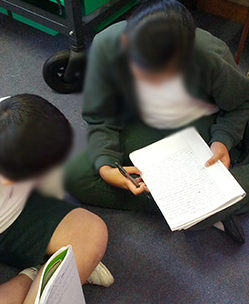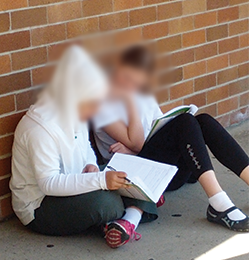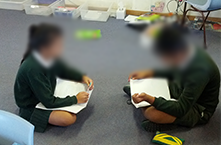I have been teaching the kids to peer edit. This involves a long process of discussing how we self-edit initially and what we are looking for when we do edit. It also involves some roleplays and discussion of how we provide feedback, what types of feedback we can provide and inappropriate comments and ways to talk to each other.
That always is an interesting conversation as the kids can immediately identify how not to talk to each other and have heaps of fun role playing that. A poster that I use is included in the product at the bottom of the post with the ideas surrounding what kids should or shouldn't do when in the role of the writer or editor.
I think constructive editing and feedback is the key. I teach my students that they need to look for certain errors within the document that all writers make but they also need to look for ways that you think as an audience to the piece of writing it could be improved and provide that feedback. I also stress that they need to say one thing that they like about the writing, this puts a positive note so that the writer doesn't feel like they are being bombarded with negative criticism. This is included in the product at the bottom of the post, in the format of stars or triangles.
There is no point, and I stress this to the students that we ever say someone's writing is bad and everyone has things they need to improve upon.
Now at the point that I am at, I can send the students just outside the classroom (any excuse to sit in the sun or open air) and they know how to edit each other's work and feedback to each other appropriately to make the time spent doing it worthwhile.

 It saves you a bit of time, so you don't need to edit and feedback on the simple errors, it also builds up cooperation among the students and I have found some of the better students pair with some of the less able students and enjoy helping them improve.
It saves you a bit of time, so you don't need to edit and feedback on the simple errors, it also builds up cooperation among the students and I have found some of the better students pair with some of the less able students and enjoy helping them improve.
It doesn't matter generally who pairs with who, because throughout the writing process they will pair multiple times with different people as everyone has different feedback to give. I do make them pair up with different people each time, not friends all the time and may given them a "Find someone who ..." question to start them off, if it takes too long or I am finding the same people being left out all the time.
I have also got them to write notes on post-it notes to give to the student, or if we are just sharing work around then they post it on the work and pass it on. This way the student gets their piece of work back with multiple positive, questions and comments on the back.
I have put up a product to support this, that I use in my classroom. It has a peer editing check list so that they can self edit their work and then also peer edit someone else's. I have put up a poster with some guidelines while undertaking this. I have also put in the stars/triangles that I use to scaffold peer feedback.
Do you use peer feedback or editing in your class? How does it work?Labels: editing, English, peer editing, peer feedback, self editing


 It saves you a bit of time, so you don't need to edit and feedback on the simple errors, it also builds up cooperation among the students and I have found some of the better students pair with some of the less able students and enjoy helping them improve.
It saves you a bit of time, so you don't need to edit and feedback on the simple errors, it also builds up cooperation among the students and I have found some of the better students pair with some of the less able students and enjoy helping them improve.